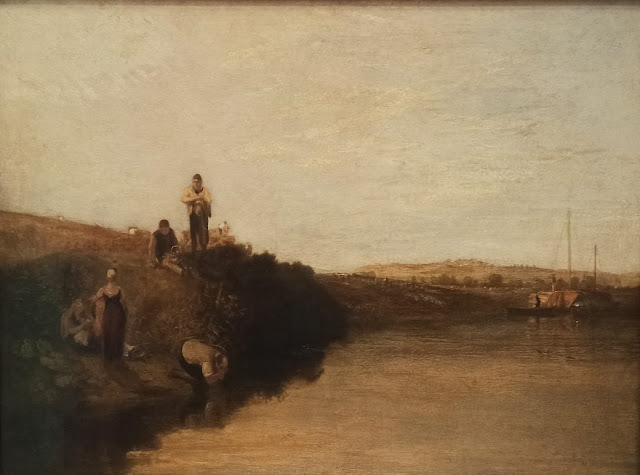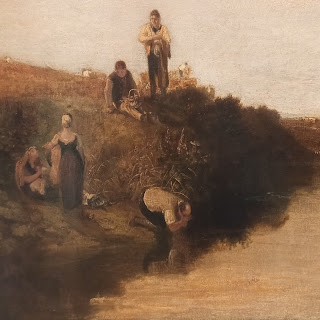Note: This is a continuation of an earlier journal entry on The Turner gallery revisited. This part focuses - as per the Tate - on the reaction to Turners' paintings when first exhibited. His works always drew a crowd; and over time his work divided opinion. I have focused on works that I haven't already reviewed.
Apologies for the desultory nature of my posting. I plan to get back on track at some point. I'm usually juggling books, travelling, and also trying to have fun. Despite the ostensible Turner obsession on this blog; I will be branching out soon. These posts focus on works not covered when I visited in 2022.
✲✲✲
Frosty Morning
This is just beautiful.
Turner didn't want to sell this painting. The Spectator said it captured the "true tone of nature, imitated to perfection". Claude Monet described it as being painted with "wide-open eyes".
I do love the crepuscular chill of this painting. The early rays of sunshine, the sweet little girl (Turner's daughter) turning up her fur coat (as she turns to face the viewer), and one horse gently caressing the other which catches some patch of grass. It looks work is being done by a couple of lads on the pathway (and overseen by her father).
The net effect is an immersive and alluring vista of bucolic charm, the matutinal chill and stillness, an adorable girl and her townsfolk.
✲✲✲
Harvest Dinner, Kingston Bank
As per Tate, Painting "much admired by JS Cotman and David Cox".
Lovely warm summers evening. A woman cradling a baby in her arms (recurring motif), and lots of people chatting, standing or sitting around with a basket of food. Interesting Turner shows us a man stooping to splashing his face, indicative of the heavy warm atmosphere. It's a nice painting.
✲✲✲
A Country Blacksmith Disputing upon the Price of Iron, and the Price Charged to the Butcher for Shoeing his Poney
This was exhibited next to newcomer David Wilkie. Turner wanted to prove that he could paint everyday life. This painting is supposed to relate the economic consequences of the Napoleonic wars. The government introduced the pig iron tax to pay for the war. Today, the price of fuel triggered by the Ukraine-Russia conflict propelled the cost of living crisis.
Although this is an everyday transaction, Turner gives us a lot of drama and charm. The two central figures discussing the price, with one holding a coin. Everyone else seems to be moving. Another blacksmith cleaning the horse's hooves, and another blacksmith holding a hammer as he forges metal into a shape. Chickens eating seeds. It's got a lot of wholesome arcadian charm despite the darker economic overtones.
I quite like this painting.
✲✲✲
Palestrina - Composition
The painting is based on "Palestrina" which is a city of ancient Rome and whose charm was noted by Virgil and Horace.
This painting is supposed to depict Italy in its decline. Its castle (dominating the environs), thick walls, bridge and fortifications are melding into the general verdant mountain. It's rare to see such a blue skyline. The place is deserted, abandoned, something long-forgotten? There are a few people conversing behind containers and wrapped parcels of food in the centre. Otherwise, the landscape is overrun by ruminants: either cows on the bridge, or sheep sauntering under the trees.
As usual, lots of romantic charm with intimations of wistfulness.
✲✲✲
Peace – Burial at Sea
This is intense and beautiful.
Turner painted this in this honour of his friend - painter David Wilkie - who died of typhoid and was buried at sea.
This is a beautiful lament. Turner paints two ships as being near-disembodied and scorched by fire. Black and powdery sails, wraith-like. Burning brightly with a blazing flame at its heart. Behind them, there's a hazy shinning, the glimmering rays of a lambent glame. Perhaps a spiritual beacon-fire to his lost friend.
According to the Tate, Turner "wished he could make them blacker still" and tied Wilkie's death to the Napoleonic War itself.
✲✲✲
War. The Exile and the Rock Limpet
Wow!
What is so striking about this art is how modern it feels. I love how Turner focuses on something; and then orbits the world around it in a misty amorphousness, a beautiful evanescence.
This is Napoleon, in exile on St. Helena, with British sentry standing watch.
A burning, fire-red, sanguinary sunset. The incarnadine atmosphere is counter-posed by a contemplative Napoleon; arms-crossed looking into his reflection in the unruffled lake (reflective being transitive). The background is one of the solitude, quietness and serenity ... surrounded by broken bridges and damaged buildings.
It's a sobering painting.
✲✲✲
Vision of Medea
This painting was originally ridiculed.
Medea is an epic character from Greek mythology. Having been rejected by the miscreant Jason, leader of the Argonauts; she decides to murder her own prepubescent children to spite her cheating husband. This has to be one of the most cruel and wicked action in a mythological tale. The enchantress sets free a snake (behind the tree in the darkness) on the children.
The painting was criticized as being too difficult to make out; and I have to agree.
I don't think this captures the evil of Medea.
✲✲✲
View of Orvieto, Painted in Rome
This is quite pleasing, but not as captivating as the others. I feel like there's something missing here. Perhaps too much enveloping darkness. It gives the painting a shade of gloom and obscurity which has the effect of concealing. The two women are bathed in radiant sunlight, perhaps from the opening in the trees. Washing clothes.
Painted in Rome 1828. Turner passed through Orvieto on his way to Rome.












No comments:
Post a Comment